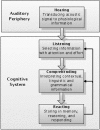The future of hearing aid technology
- PMID: 17301336
- PMCID: PMC4111503
- DOI: 10.1177/1084713806298004
The future of hearing aid technology
Abstract
Hearing aids have advanced significantly over the past decade, primarily due to the maturing of digital technology. The next decade should see an even greater number of innovations to hearing aid technology, and this article attempts to predict in which areas the new developments will occur. Both incremental and radical innovations in digital hearing aids will be driven by research advances in the following fields: (1) wireless technology, (2) digital chip technology, (3) hearing science, and (4) cognitive science. The opportunities and limitations for each of these areas will be discussed. Additionally, emerging trends such as connectivity and individualization will also drive new technology, and these are discussed within the context of the areas given here.
Figures
References
-
- Strom KE. The HR 2006 Dispenser Survey. Hear Rev. 2006;13: 16–39
-
- De Gennaro S, Braida LD, Durlach NI. Multichannel syllabic compression for severely impaired listeners. J Rehabil Res Dev. 1986;23: 17–24 - PubMed
-
- Lippmann RP, Braida LD, Durlach NI. Study of multichannel amplitude compression and linear amplification for persons with sensorineural hearing loss. J Acoust Soc Am. 1981;69: 524–534 - PubMed
-
- Plomp R. The negative effect of amplitude compression in multichannel hearing aids in the light of the modulation-transfer function. J Acoust Soc Am. 1988;83: 2322–2327 - PubMed
-
- Kochkin S. MarkeTrak VII: Customer satisfaction with hearing instruments in the digital age. Hear J. 2005;58: 30–42
MeSH terms
LinkOut - more resources
Full Text Sources
Other Literature Sources
Medical
Miscellaneous


